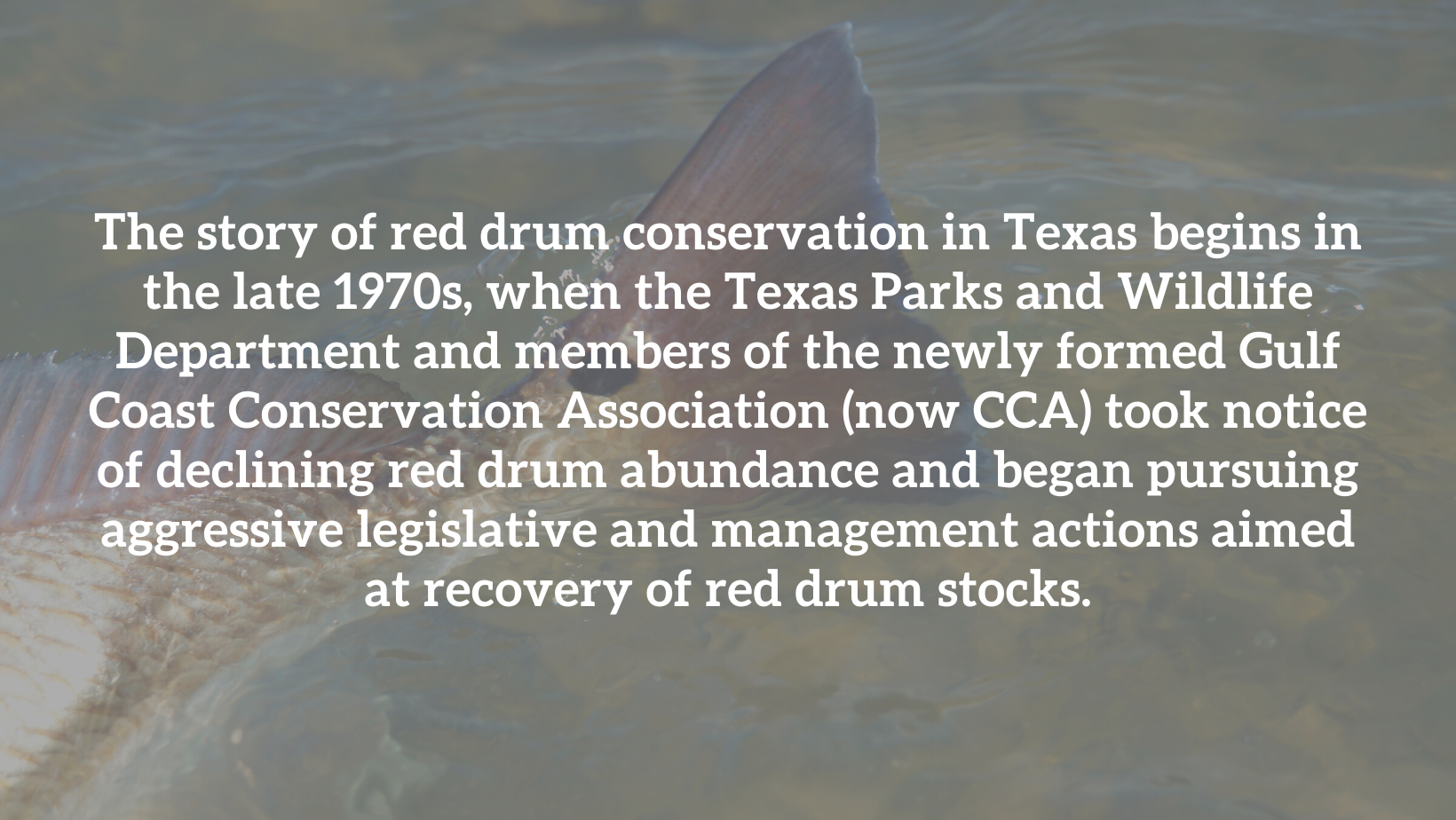
By Joel Anderson and Shane Bonnot
The Texas red drum, commonly known as redfish or simply “red,” has a storied history unique within the annals of fisheries management and coastal advocacy. Today’s anglers enjoy a vibrant and sustainable fishery made possible by conservation pioneers who set into motion a series of events to save the bison of the bays. The forecast for sustainability of the Texas Red drum population has not always been a positive one.
The story of red drum conservation in Texas begins in the late 1970s, when the Texas Parks and Wildlife Department and members of the newly formed Gulf Coast Conservation Association (now CCA) took notice of declining red drum abundance and began pursuing aggressive legislative and management actions aimed at recovery of red drum stocks. The first daily bag limits were set for sport and commercial fishermen in Texas in 1977. Then, in 1981, Texas House Bill 1000 (aka the Redfish Bill) was passed, which permanently prohibited the sale of red drum caught in state waters. This measure alone effectively ended the commercial harvest of red drum in Texas. Three other Gulf states (Florida, Alabama, and Louisiana) have since passed similar measures.
The fishery was closed permanently in the federal exclusive economic zone in the Gulf in 1987 (the “EEZ” are the federal waters just outside state jurisdiction and extending 200 nautical miles from shore). Notably, former Texas Gov. George W. Bush consolidated federal protection of the species across its natural range (including the Atlantic coast) with a 2007 Presidential executive order (EO 13449) that permanently prohibited the sale of any red drum caught in the EEZ.
Along with these forward-thinking fisheries management measures, TPWD and conservation leaders began working on a vision for stock enhancement that could pair with fisheries management to accelerate recovery. The first marine stock enhancement facility was opened in 1982 through a public-private partnership between TPWD, CCA, and the Central Power and Light Company, which provided land for a hatchery in Corpus Christi. Stocking began in 1983 when 7 million red drum fingerlings were released coastwide in Texas. Presently, TPWD operates stock enhancement facilities in Corpus Christi, Palacios and Lake Jackson, which are heavily supported by CCA. The agency releases anywhere between 10 to 20 million red drum annually, depending upon management needs and natural recruitment estimates based on TPWD field samples from the previous year. Since the inception of the enhancement program, more than 820 million red drum fingerlings have been released along the Texas Coast.
Perhaps as a result of this monumental investment of time, energy and capital into its management and recovery, catch rates for red drum increased throughout the 1980s and into the 1990s based on data from TPWD’s long-running gill net surveys. Over the most recent 10 years, anglers that reported that they targeted red drum specifically have also reported an average trip satisfaction grade of 8 on a scale of 1 to 10, based on data from TPWD’s angler intercept program (also known as the Texas “creel” survey).
It would be tempting to look at the current state of red drum angling in Texas and declare victory. But scientific rigor requires a systematic assessment of what recovery looks like from a biological standpoint. To that end, TPWD biologists started investigating whether there was a way to retrospectively examine changes in size and age of the population during the recovery.
In the late 1990s, researchers at the Perry R. Bass Marine Fisheries Research Station within TPWD initiated collection of tissue structures called “otoliths” from red drum caught coastwide. Otoliths are hard sensory structures near the brain of a fish that perform functions that are similar to the inner ear bones in mammals. In some species (including red drum) otoliths lay down perennial rings, or “annuli,” similar to tree rings. If properly treated and examined microscopically, these annuli give an accounting of the exact age of a fish. Perhaps more importantly, these structures allow scientists to link the average size of a fish to a given age range.
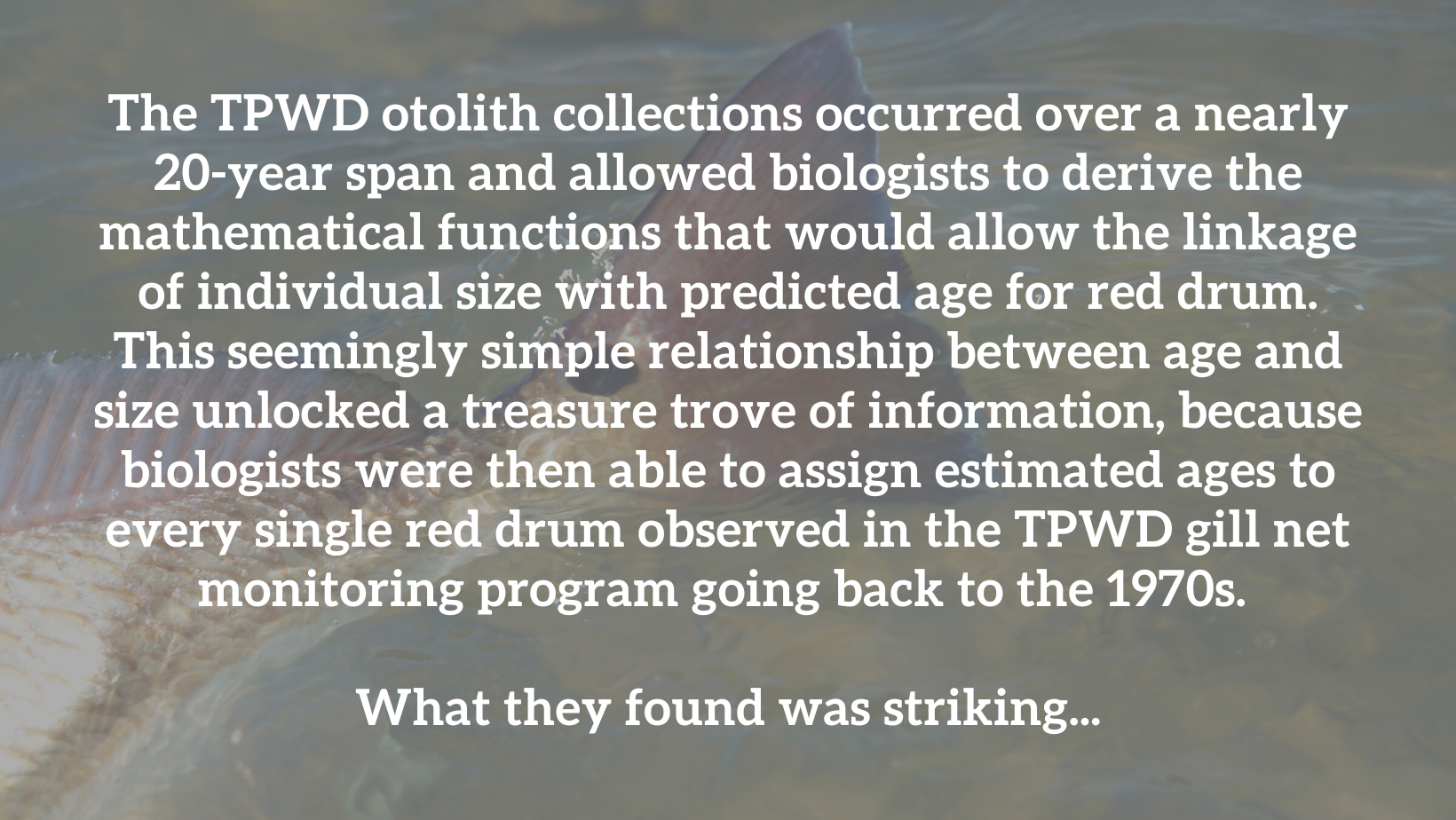
The TPWD otolith collections occurred over a nearly 20-year span and allowed biologists to derive the mathematical functions that would allow the linkage of individual size with predicted age for red drum. This seemingly simple relationship between age and size unlocked a treasure trove of information, because biologists were then able to assign estimated ages to every single red drum observed in the TPWD gill net monitoring program going back to the 1970s.
What they found was striking.
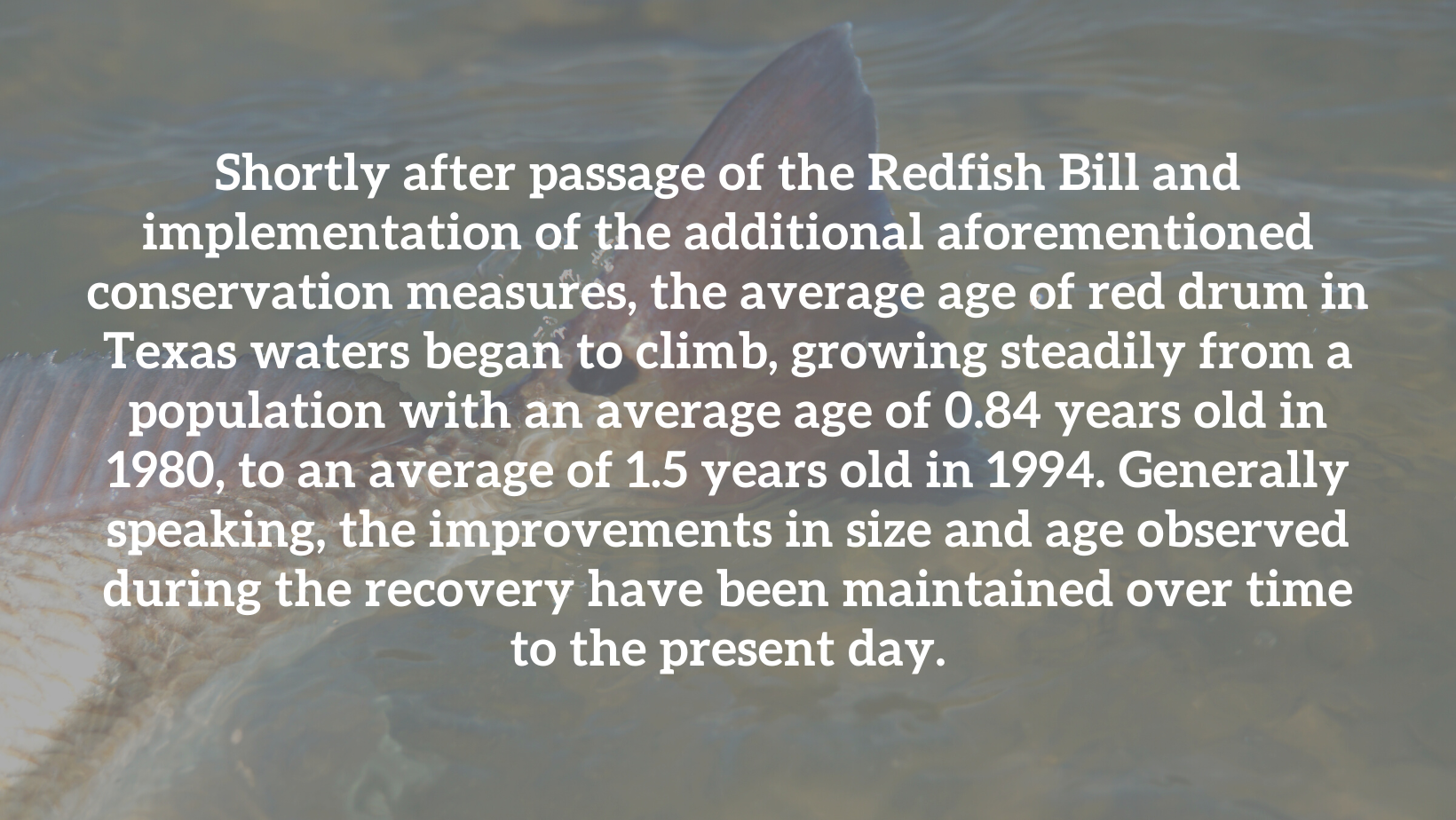
Shortly after passage of the Redfish Bill and implementation of the additional aforementioned conservation measures, the average age of red drum in Texas waters began to climb, growing steadily from a population with an average age of 0.84 years old in 1980, to an average of 1.5 years old in 1994. The difference was notable for anglers as well, as the mean size of red drum observed in the gill net survey increased from 16.5 inches in 1980, to approximately 19.6 inches in 1994. Generally speaking, the improvements in size and age observed during the recovery have been maintained over time to the present day.
Age data through time were also used to estimate important fisheries characteristics like mortality rate, which is simply the rate at which individuals are removed from the population through fishing, predation, disease, or other factors. Based on the otolith data, mortality in today’s estuarine red drum population occurs at a rate that is about 50 percent of what it was in 1981, and as a result, the number of fish that grow to reproductive maturity and that escape to the offshore spawning population is approximately double what it once was. This is an important point, because red drum in Texas’ estuaries support the bulk of the recreational fishery, but they also represent the next generation of spawners that are tasked with sustaining viable population numbers as they mature and move offshore.
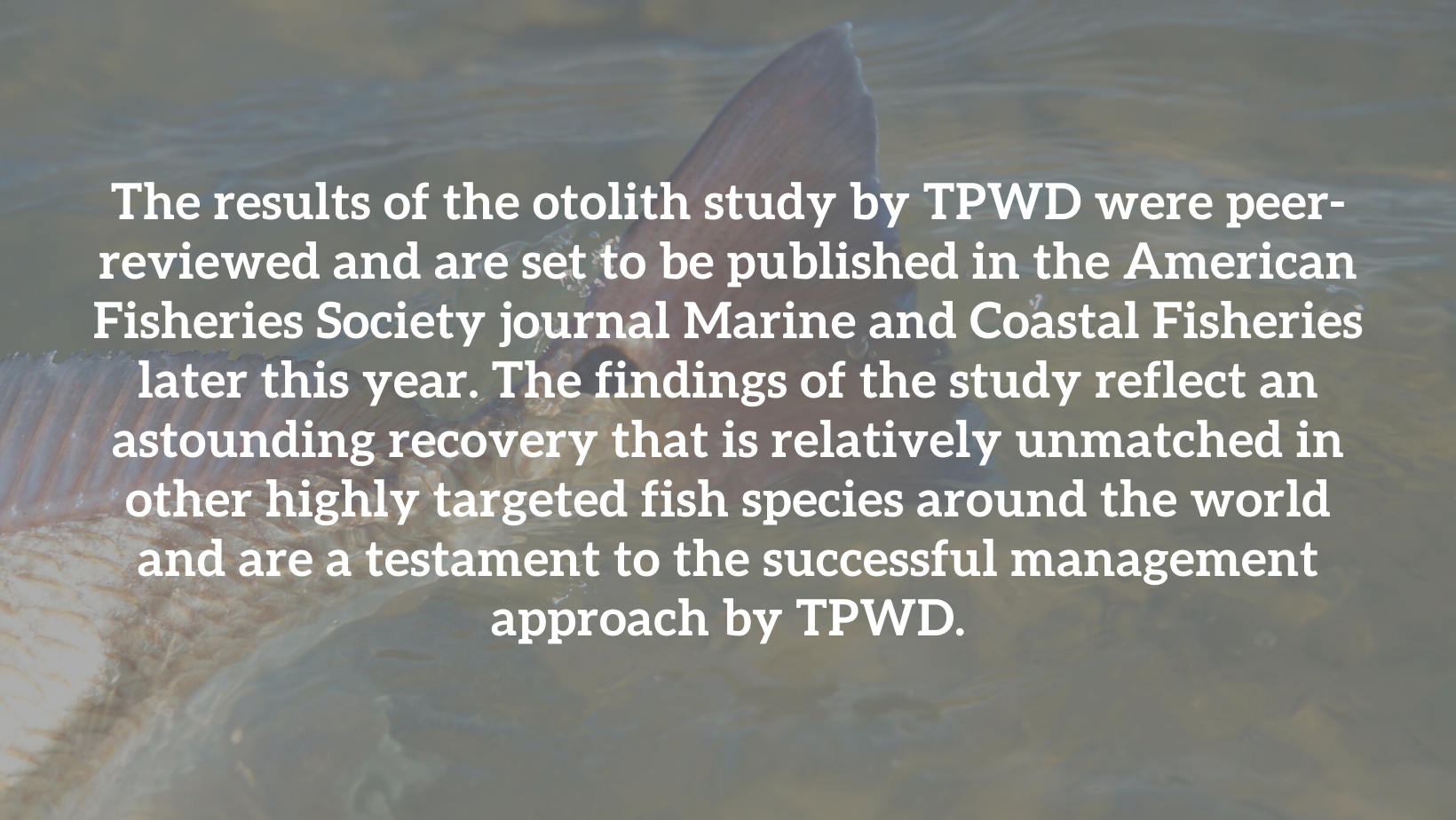
The results of the otolith study by TPWD were peer-reviewed and are set to be published in the American Fisheries Society journal Marine and Coastal Fisheries later this year. The findings of the study reflect an astounding recovery that is relatively unmatched in other highly targeted fish species around the world and are a testament to the successful management approach by TPWD.
The people and events intertwined in this recovery forever changed the role of recreational anglers in fisheries management, creating a conservation ethic that is now woven into coastal fishing culture. Through cooperation between government agencies like TPWD, non-government advocacy groups like CCA, and an army of conservation-minded anglers, the Texas red drum represents a conservation success story that continues to be written, and a standard for how research, management, and citizen advocacy can change the future of an iconic coastal species.
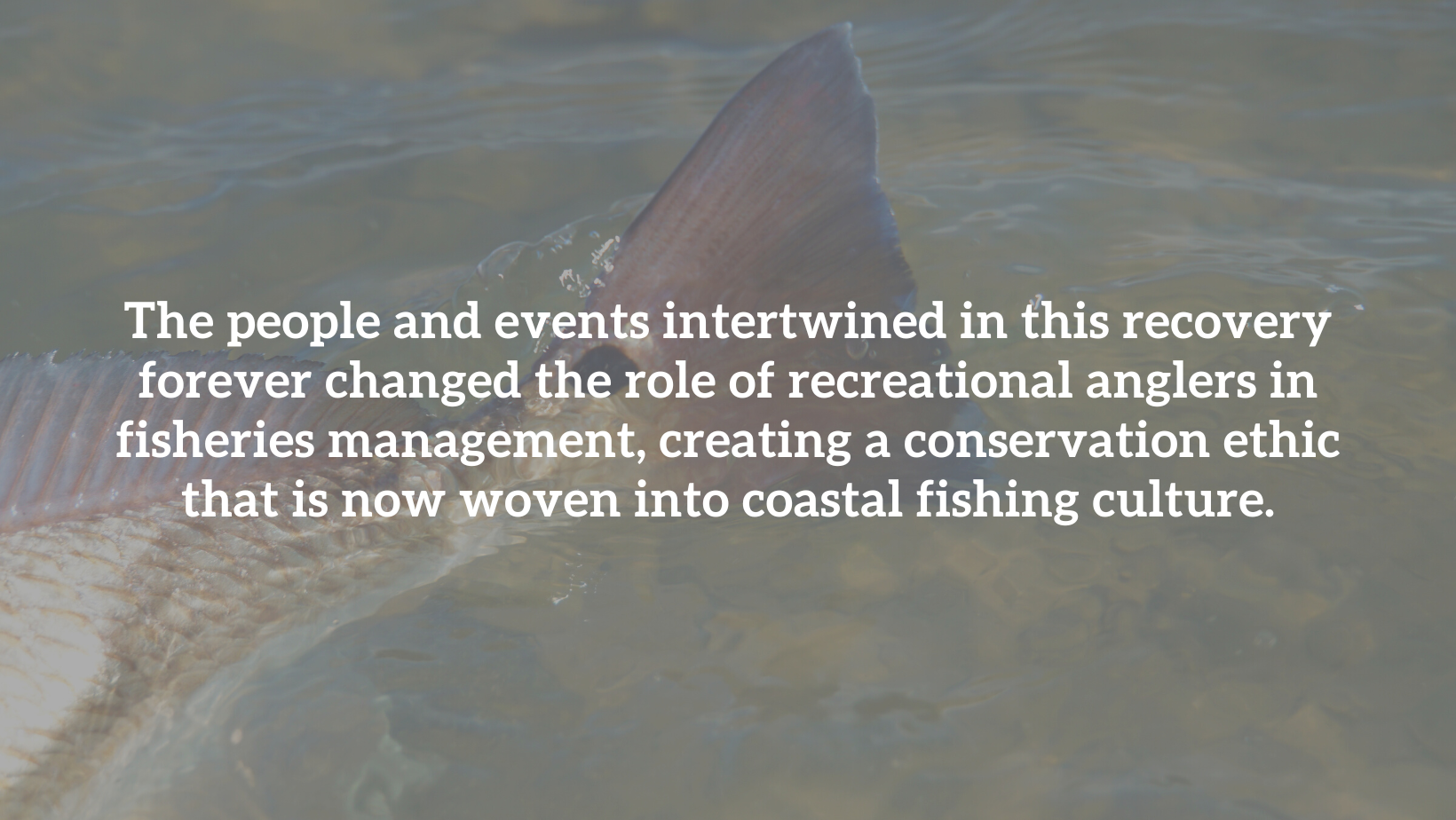
Joel Anderson is a Texas A&M graduate and a 19-year veteran of the Coastal Fisheries division of Texas Parks and Wildlife. He is currently the facility manager at TPWD’s Perry R. Bass Marine Fisheries Research Station and Hatchery in Palacios, and team leader for research at that facility.
Shane Bonnot in a graduate of Texas A&M University and Texas A&M University – Corpus Christi. He was employed for 10 years with Texas Parks and Wildlife – Coastal Fisheries Division within the Saltwater Fisheries Enhancement Program, and currently works as Advocacy Director for CCA Texas.





